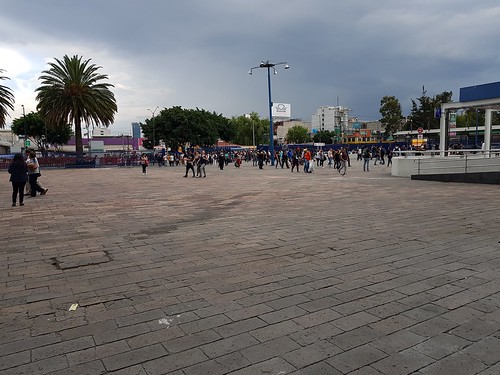He animal experiments were approved (License Number 129/2009) by the Ethics Committee 15900046 of the Veterinary Office of the Kanton Zurich ?and were conducted in accordance with the guidelines of the “Schweizer Bundesamt fur Veterinarwesen”. On day 0 of the ??experiments, 26105 of 143-B cells (engineered as described) in 10 ml of PBS/0.05 EDTA containing Matrigel (BectonDickinson; Franklin Lake, NJ) were injected intratibially. After the injections, the health condition of the mice was closely monitored. Tumor development was examined weekly by X-ray with an MX-20 DC Digital Radiography System (Faxitron X-Ray Corporation, Lincolnshire, IL) and by caliper measurements of the length and the width of the tumor leg from which the tumor volume was calculated with the formula V = length 6 width2/2. The mice were sacrificed 21 days after tumor cell injection and in situ lung perfusion was performed as described [23]. Organs collected at sacrifice were fixed in 2 formaldehyde at RT for 30 min, washed three times with PBS and LacZ gene expressing tumor cells were stained with 5-bromo-4-chloro-3-indolyl-b-Dgalactoside (X-Gal) staining solution at 37uC for at least 3 h as described [24,25]. The indigo-blue stained metastases on the lung surface were counted under the microscope. The animal experiments were carried out three times. The data of a representative experiment are shown.Migration assayTranswell migration assays were performed as recently reported [23]. Briefly, 52106103 cells were allowed to migrate at 37uC for 6 h through 8 mm porous polycarbonate filters of cell culture inserts (Becton Dickinson, San Jose, CA) fitting into 24-well plates. Cells remaining on the upper side of the 117793 filter insert were considered as non-migrating cells and removed by wiping with a cotton swab. Migrated cells on the lower side of the filters were fixed with 10 formalin in PBS, permeabilized with 50 mM digitonin (Calbiochem; Switzerland) and stained with 300 nM Picogreen in PBS (Invitrogen) at RT for 15 min. Three randomly selected filter areas of 0.58 mm2 per insert (two filters per cell line) were photographed with an AxioCam MRm camera connected to the Zeiss Observer.Z1 inverted microscope equipped with an appropriate filter block for blue excitation and set to 106 magnification. The number of cells that migrated to the lower side of the polycarbonate filters was determined with ImageJ software. The results are presented as described for the adhesion assay. The experiments were carried out at least three times.ImmunohistochemistryTumors and lungs previously fixed in 4 formaldehyde were dehydrated through serial incubation in 70 , 96 , 100 ethanol and xylene and then embedded in paraffin. Sections of 6 mm were mounted onto slides, deparaffinized and rehydrated and then heated in 0.1 M citrate buffer (pH 5.8) for antigen retrieval. Endogenous peroxidase was inactivated 1326631 by incubation of the tissue sections in 3 H2O2 at RT for 10 min. Non-specific binding of antibodies to tissue sections was blocked by incubation at RT for 1 h in Tris buffered saline (TBS; 50 mM Tris, 150 mM NaCl, pH 7.4) that contained 10 goat serum (Vector CP21 site Laboratories; Burlingame, CA) and 0.1 Tween (Sigma Aldrich). Primary Hermes3 CD44 antibodies (2 mg/ml in blocking solution), and antibodies to merlin  NF2 (Santa Cruz Biotechnologies; 4 mg/ml) and to Ki67 (Abcam; Cambridge, UK; 4 mg/ml) were then applied and the slides incubated at RT for 1 h. After washing with TBS, the slides were incu.He animal experiments were approved (License Number 129/2009) by the Ethics Committee 15900046 of the Veterinary Office of the Kanton Zurich ?and were conducted in accordance with the guidelines of the “Schweizer Bundesamt fur Veterinarwesen”. On day 0 of the ??experiments, 26105 of 143-B cells (engineered as described) in 10 ml of PBS/0.05 EDTA containing Matrigel (BectonDickinson; Franklin Lake, NJ) were injected intratibially. After
NF2 (Santa Cruz Biotechnologies; 4 mg/ml) and to Ki67 (Abcam; Cambridge, UK; 4 mg/ml) were then applied and the slides incubated at RT for 1 h. After washing with TBS, the slides were incu.He animal experiments were approved (License Number 129/2009) by the Ethics Committee 15900046 of the Veterinary Office of the Kanton Zurich ?and were conducted in accordance with the guidelines of the “Schweizer Bundesamt fur Veterinarwesen”. On day 0 of the ??experiments, 26105 of 143-B cells (engineered as described) in 10 ml of PBS/0.05 EDTA containing Matrigel (BectonDickinson; Franklin Lake, NJ) were injected intratibially. After  the injections, the health condition of the mice was closely monitored. Tumor development was examined weekly by X-ray with an MX-20 DC Digital Radiography System (Faxitron X-Ray Corporation, Lincolnshire, IL) and by caliper measurements of the length and the width of the tumor leg from which the tumor volume was calculated with the formula V = length 6 width2/2. The mice were sacrificed 21 days after tumor cell injection and in situ lung perfusion was performed as described [23]. Organs collected at sacrifice were fixed in 2 formaldehyde at RT for 30 min, washed three times with PBS and LacZ gene expressing tumor cells were stained with 5-bromo-4-chloro-3-indolyl-b-Dgalactoside (X-Gal) staining solution at 37uC for at least 3 h as described [24,25]. The indigo-blue stained metastases on the lung surface were counted under the microscope. The animal experiments were carried out three times. The data of a representative experiment are shown.Migration assayTranswell migration assays were performed as recently reported [23]. Briefly, 52106103 cells were allowed to migrate at 37uC for 6 h through 8 mm porous polycarbonate filters of cell culture inserts (Becton Dickinson, San Jose, CA) fitting into 24-well plates. Cells remaining on the upper side of the filter insert were considered as non-migrating cells and removed by wiping with a cotton swab. Migrated cells on the lower side of the filters were fixed with 10 formalin in PBS, permeabilized with 50 mM digitonin (Calbiochem; Switzerland) and stained with 300 nM Picogreen in PBS (Invitrogen) at RT for 15 min. Three randomly selected filter areas of 0.58 mm2 per insert (two filters per cell line) were photographed with an AxioCam MRm camera connected to the Zeiss Observer.Z1 inverted microscope equipped with an appropriate filter block for blue excitation and set to 106 magnification. The number of cells that migrated to the lower side of the polycarbonate filters was determined with ImageJ software. The results are presented as described for the adhesion assay. The experiments were carried out at least three times.ImmunohistochemistryTumors and lungs previously fixed in 4 formaldehyde were dehydrated through serial incubation in 70 , 96 , 100 ethanol and xylene and then embedded in paraffin. Sections of 6 mm were mounted onto slides, deparaffinized and rehydrated and then heated in 0.1 M citrate buffer (pH 5.8) for antigen retrieval. Endogenous peroxidase was inactivated 1326631 by incubation of the tissue sections in 3 H2O2 at RT for 10 min. Non-specific binding of antibodies to tissue sections was blocked by incubation at RT for 1 h in Tris buffered saline (TBS; 50 mM Tris, 150 mM NaCl, pH 7.4) that contained 10 goat serum (Vector Laboratories; Burlingame, CA) and 0.1 Tween (Sigma Aldrich). Primary Hermes3 CD44 antibodies (2 mg/ml in blocking solution), and antibodies to merlin NF2 (Santa Cruz Biotechnologies; 4 mg/ml) and to Ki67 (Abcam; Cambridge, UK; 4 mg/ml) were then applied and the slides incubated at RT for 1 h. After washing with TBS, the slides were incu.
the injections, the health condition of the mice was closely monitored. Tumor development was examined weekly by X-ray with an MX-20 DC Digital Radiography System (Faxitron X-Ray Corporation, Lincolnshire, IL) and by caliper measurements of the length and the width of the tumor leg from which the tumor volume was calculated with the formula V = length 6 width2/2. The mice were sacrificed 21 days after tumor cell injection and in situ lung perfusion was performed as described [23]. Organs collected at sacrifice were fixed in 2 formaldehyde at RT for 30 min, washed three times with PBS and LacZ gene expressing tumor cells were stained with 5-bromo-4-chloro-3-indolyl-b-Dgalactoside (X-Gal) staining solution at 37uC for at least 3 h as described [24,25]. The indigo-blue stained metastases on the lung surface were counted under the microscope. The animal experiments were carried out three times. The data of a representative experiment are shown.Migration assayTranswell migration assays were performed as recently reported [23]. Briefly, 52106103 cells were allowed to migrate at 37uC for 6 h through 8 mm porous polycarbonate filters of cell culture inserts (Becton Dickinson, San Jose, CA) fitting into 24-well plates. Cells remaining on the upper side of the filter insert were considered as non-migrating cells and removed by wiping with a cotton swab. Migrated cells on the lower side of the filters were fixed with 10 formalin in PBS, permeabilized with 50 mM digitonin (Calbiochem; Switzerland) and stained with 300 nM Picogreen in PBS (Invitrogen) at RT for 15 min. Three randomly selected filter areas of 0.58 mm2 per insert (two filters per cell line) were photographed with an AxioCam MRm camera connected to the Zeiss Observer.Z1 inverted microscope equipped with an appropriate filter block for blue excitation and set to 106 magnification. The number of cells that migrated to the lower side of the polycarbonate filters was determined with ImageJ software. The results are presented as described for the adhesion assay. The experiments were carried out at least three times.ImmunohistochemistryTumors and lungs previously fixed in 4 formaldehyde were dehydrated through serial incubation in 70 , 96 , 100 ethanol and xylene and then embedded in paraffin. Sections of 6 mm were mounted onto slides, deparaffinized and rehydrated and then heated in 0.1 M citrate buffer (pH 5.8) for antigen retrieval. Endogenous peroxidase was inactivated 1326631 by incubation of the tissue sections in 3 H2O2 at RT for 10 min. Non-specific binding of antibodies to tissue sections was blocked by incubation at RT for 1 h in Tris buffered saline (TBS; 50 mM Tris, 150 mM NaCl, pH 7.4) that contained 10 goat serum (Vector Laboratories; Burlingame, CA) and 0.1 Tween (Sigma Aldrich). Primary Hermes3 CD44 antibodies (2 mg/ml in blocking solution), and antibodies to merlin NF2 (Santa Cruz Biotechnologies; 4 mg/ml) and to Ki67 (Abcam; Cambridge, UK; 4 mg/ml) were then applied and the slides incubated at RT for 1 h. After washing with TBS, the slides were incu.